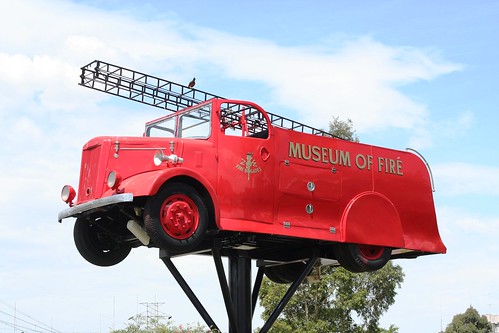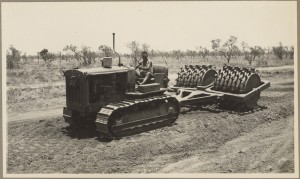Jenny Sloggett is an Archivist working in the Archives Control and Management section of State Records NSW.
![Darwin wharf after enemy raid - Dept Main Roads, RNICG [6/17261, p.50, No. 1], Northern Territory Work, 1942, Photo by Mr James.](/wp-content/uploads/2012/02/Darwin-wharf-after-enemy-raid.jpg)
Darwin Wharf after Enemy Raid 1942
State Records is highlighting a connection between New South Wales and Darwin in its ‘War and Australia’ Digital Gallery. In 1941 and 1942 the NSW Board of Fire Commissioners released two Dennis ‘Light 4’ fire engines from service so that they could be quickly sent to Darwin. But what happened to them after 1942?
From 1926 fires at Darwin had been fought using a cylinder on a handcart that used chemicals to create water pressure and was operated by the police. But with the new town water supply for Darwin almost finished in June 1941, the Army, the Darwin Anti-Aircraft committee, the local newspaper and concerned citizens called for a fire brigade. The Queensland Fire Brigade conducted a review, recommended in favour of a fire brigade, and the Federal Cabinet agreed.

The State Library of Victoria has an image of a fire cart photographed in 1941 in the Northern Territory. Is this the 1926 handcart?
New South Wales was asked to supply equipment for the Darwin Fire Brigade. On 18 September 1941 it sent hose, branches and nozzles via a Qantas flying boat. On 29 September a Dennis ‘Light 4’ Fire Engine, No 269, was sent on the SS “Marella” and arrived at Darwin a fortnight later. The ‘Light 4’ was a new model developed by Dennis Bros in 1938 to replace the Dennis ‘Ace‘. The engine sent to the Northern Territory had only been in use in NSW for ten months and was previously based at Lidcombe. Its Chassis number was 3017 and its Engine number 141069.013. It was in Darwin when the Japanese attacked on 19 February.
A second fire engine, also a Dennis ‘Light 4’ No 269A, was despatched from Sydney per the SS “Montora” on 25 February 1942 and had a longer trip. It had previously been in service at Lidcombe for 5 months. Because of the bombing of Darwin, the ship was held in Townsville and the fire engine was to be transferred to a smaller vessel, the “Tulagi”, for Darwin. Some reports suggest the fire engine reached Darwin and was sent back to Sydney, only to be returned to Darwin. It finally arrived on 7 April. It was taken over by the Navy, as the Darwin Fire Brigade had been disbanded. Its Chassis number was 3014 and its Engine number 140997.013. The first engine was taken over by the Army and stationed at Larrakeyah.
Did they survive the war?

R J (Lou) Cowan tells us, via the Museum of Fire at Penrith, that:
In 1946 the civilian fire brigade started up again, and the Fire Brigade took back possession of the two Dennis Light 4s, which must have passed through the war years relatively unscathed. These appliances remained in service in Darwin for many years…. the Light 4s [were next] in service in Alice [Springs], where both finally ended up before finally being decommissioned. I have heard that both Light 4s ended up in sand pits in the Alice area pumping water for washing sand.
The Northern Territory Library has an image of a fire engine at Alice Springs photographed in the late 1950’s.
Lou states it is one of the Dennis Light 4s from New South Wales.
Acknowledgements:
Our thanks to Lou and to Mark White of the Museum of Fire, Penrith, for satisfying our curiosity as to what became of the Dennis ‘Light 4’ fire engines from New South Wales that served in Darwin.
Sources:
Board of Fire Commissioners; NRS 476, Special bundles, 1884-1971; [20/14783], 599 Darwin, 1941-1942.
Gary Boyce, ‘Involvement of the NSW Fire Brigade in the formation of the Darwin Fire Brigade 1941, unpublished manuscript, 2009, courtesy of the Museum of Fire
Darwin Fire Brigade History




![Darwin wharf after enemy raid - Dept Main Roads, RNICG [6/17261, p.50, No. 1], Northern Territory Work, 1942, Photo by Mr James.](/wp-content/uploads/2012/02/Darwin-wharf-after-enemy-raid.jpg)

